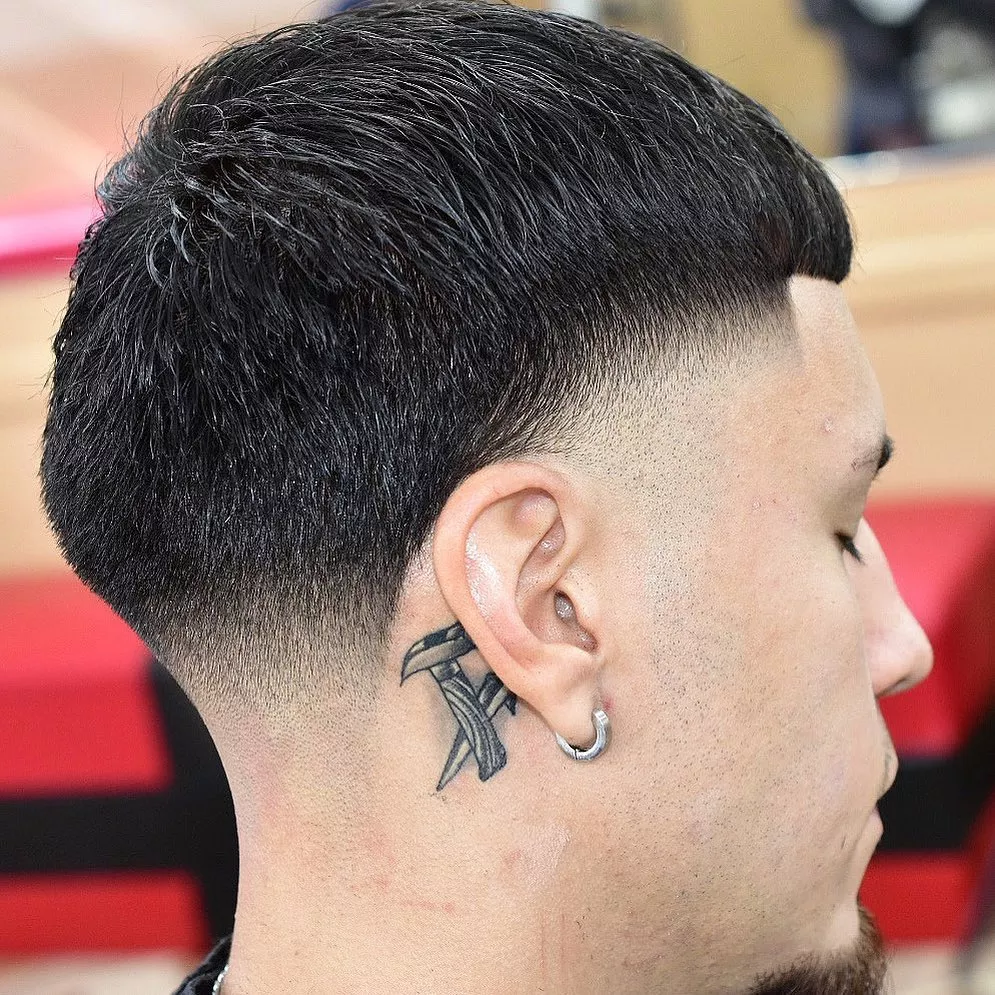Taper Drawing: A Comprehensive Guide To Mastering The Art
So, you've probably heard about taper drawing, right? Maybe you're an aspiring artist looking to sharpen your skills or just someone curious about this fascinating technique. Well, buckle up because we're diving deep into the world of taper drawing. This isn't just about lines and curves; it's about creating depth, dimension, and that jaw-dropping effect that makes people go, "Whoa!" Taper drawing is a game-changer in the art world, and today, we're breaking it down for you step by step. Let's get started, shall we?
Now, before we jump into the nitty-gritty, let's talk about why taper drawing matters. If you've ever looked at a piece of art and wondered how the artist made it look so realistic, chances are they used tapering techniques. It's one of those skills that separates the amateurs from the pros. Think about it—those smooth transitions, the way shadows blend perfectly with highlights, it's all about tapering. And guess what? You can totally master this too!
But wait, here's the kicker—taper drawing isn't just for pencil sketches. Oh no, it's a versatile technique that works across various mediums, from digital art to watercolors. Whether you're sketching on paper or using a tablet, understanding tapering will elevate your work to the next level. So, whether you're a beginner or a seasoned artist, this guide has got you covered. Let's dive in!
What Exactly is Taper Drawing?
Taper drawing is essentially the art of creating smooth transitions in your artwork. It's all about gradually reducing the thickness of lines or tones to give your piece that polished, professional look. Think of it like this: imagine drawing a stick figure. If the arms and legs are just straight lines, it looks kind of flat, right? But if you taper those lines, making them gradually thinner as they extend, suddenly your stick figure has depth and character. Cool, huh?
Here’s a fun fact: tapering isn’t just for lines. It also applies to shading and coloring. When you're blending colors or tones, tapering ensures that the transition is seamless. For instance, if you're coloring a sunset, you don't want harsh lines where one color ends and another begins. Instead, you want a gradual blend, and that's where tapering comes into play.
Now, let's break it down even further. Taper drawing involves understanding how light interacts with surfaces. When light hits an object, it creates highlights and shadows. By mastering tapering, you can replicate these effects in your art, making your work look more realistic and dynamic. It's like giving your art a little extra "oomph!"
- Movierulz Proxies Risks Legal Alternatives What You Need To Know
- Cinema Cafe Edinburgh Showtimes Trailers More Chesapeake Va
Why is Taper Drawing Important in Art?
Let’s face it—no one wants their art to look flat or lifeless. That's where taper drawing steps in. It adds that essential dimension that makes art pop. Imagine drawing a tree. If you don’t taper the branches, they’ll look stiff and unnatural. But with tapering, those branches will flow smoothly, mimicking how they grow in real life. It's these little details that make all the difference.
Moreover, taper drawing helps in creating visual hierarchy. In simpler terms, it guides the viewer's eye through your artwork. By using tapering techniques, you can direct attention to specific areas, making your piece more engaging. For example, if you're drawing a portrait, tapering the lines around the eyes can make them stand out, drawing the viewer's focus.
Understanding the Basics of Taper Drawing
Before we dive into advanced techniques, it's crucial to grasp the basics. Taper drawing starts with understanding lines. Every line you draw has a beginning and an end, and tapering is all about controlling how those lines change in thickness. It’s like a dance between your hand and the medium you’re using.
One of the simplest ways to practice tapering is by drawing basic shapes. Start with an oval or a circle and try tapering the lines as you extend them. This exercise helps build muscle memory and improves your control. Trust me, it works wonders!
Another important aspect is pressure control. Whether you're using a pencil or a digital pen, the amount of pressure you apply affects the thickness of your lines. Practice varying your pressure to create smooth tapers. It might take some time to get the hang of it, but with practice, you'll be tapering like a pro in no time.
Tools You Need for Taper Drawing
Now that we’ve covered the basics, let’s talk about the tools. For traditional artists, a good set of pencils is essential. Look for pencils with varying hardness, like 2B, 4B, and 6B. These allow you to create a range of tapers, from light to dark. If you're into digital art, invest in a good graphics tablet and a pen with pressure sensitivity. This will give you the flexibility to create smooth tapers digitally.
Here’s a quick list of must-have tools:
- Pencils (2B, 4B, 6B)
- Eraser (kneaded and regular)
- Graphics tablet (for digital artists)
- Drawing paper (smooth or textured, depending on your preference)
- Blending tools (stumps or tortillons for shading)
Mastering Tapering Techniques
Once you’ve got the basics down, it’s time to level up your skills. There are several tapering techniques you can explore, each with its own unique application. For instance, cross-hatching involves layering lines in different directions to create depth. By tapering these lines, you can achieve stunning shading effects.
Another technique is stippling, where you use dots to create shading. Tapering comes into play here by varying the size and density of the dots. This technique is perfect for creating textured surfaces or intricate details.
For those into digital art, layering is a powerful tool. By creating separate layers for different elements of your artwork, you can taper each layer individually, giving you ultimate control over the final result. It’s like building a puzzle, where each piece fits perfectly into place.
Common Mistakes to Avoid in Taper Drawing
Even the best artists make mistakes, and taper drawing is no exception. One common mistake is being too heavy-handed. If you press too hard, your lines won’t taper smoothly. Instead, they’ll look jagged and uneven. The key is to maintain consistent pressure throughout the line.
Another mistake is rushing the process. Tapering requires patience and precision. Take your time to ensure each line flows seamlessly into the next. Remember, practice makes perfect, so don’t get discouraged if your first attempts don’t turn out as expected.
Advanced Tips for Taper Drawing
Ready to take your taper drawing to the next level? Here are some advanced tips to help you refine your skills. First, experiment with different mediums. While pencils are great for beginners, trying out ink or charcoal can add a new dimension to your work. Each medium has its own unique properties, and learning how to taper with them will expand your artistic repertoire.
Second, study real-life objects. Observe how light and shadow interact with surfaces in the real world. This will give you a better understanding of how to replicate those effects in your art. For instance, notice how the edges of a leaf taper naturally. By studying these details, you can incorporate them into your drawings.
Lastly, don’t be afraid to mix techniques. Combining tapering with other shading methods, like stippling or cross-hatching, can create stunning results. It’s all about finding what works best for you and your style.
Real-Life Applications of Taper Drawing
Taper drawing isn’t just for artists. It has practical applications in various fields, from architecture to product design. Architects use tapering techniques to create detailed blueprints, ensuring that every line flows smoothly. Product designers rely on tapering to create realistic renderings of their products, highlighting every curve and contour.
Even in fashion design, tapering plays a crucial role. Think about how clothing drapes over the body. By understanding tapering, designers can create garments that fit perfectly and flatter the wearer. It’s all about attention to detail and creating a seamless experience.
How to Practice Taper Drawing Effectively
Practice makes perfect, and taper drawing is no exception. Start with simple exercises, like drawing straight lines and gradually tapering them. Then move on to more complex shapes, like circles and ovals. The key is consistency. Set aside time each day to practice, even if it’s just for a few minutes.
Another effective way to practice is by copying the works of master artists. Study their techniques and try to replicate them in your own style. This not only improves your skills but also gives you a deeper appreciation for the art form.
Finally, don’t forget to experiment. Art is all about creativity, so don’t be afraid to try new things. Whether it’s using a different medium or combining techniques, the more you experiment, the more you’ll grow as an artist.
Resources for Learning Taper Drawing
There’s a wealth of resources available for those looking to learn taper drawing. Online tutorials, books, and even workshops can provide valuable insights and guidance. Websites like YouTube and Skillshare offer countless tutorials from professional artists, covering everything from basic techniques to advanced tips.
Books like "Drawing on the Right Side of the Brain" by Betty Edwards are also excellent resources. They provide in-depth explanations and exercises to help you master various drawing techniques, including tapering.
Conclusion: Take Your Art to the Next Level
Taper drawing is more than just a technique; it’s a skill that can elevate your art to new heights. By mastering tapering, you can create depth, dimension, and realism in your work. Whether you’re a beginner or a seasoned artist, there’s always room to grow and improve.
So, what are you waiting for? Grab your pencils or fire up your tablet and start practicing. Remember, the key to success is consistency and patience. And don’t forget to share your progress with the world. Who knows? Your next masterpiece might just inspire someone else to pick up a pencil and start drawing.
Table of Contents
- What Exactly is Taper Drawing?
- Why is Taper Drawing Important in Art?
- Understanding the Basics of Taper Drawing
- Tools You Need for Taper Drawing
- Mastering Tapering Techniques
- Common Mistakes to Avoid in Taper Drawing
- Advanced Tips for Taper Drawing
- Real-Life Applications of Taper Drawing
- How to Practice Taper Drawing Effectively
- Resources for Learning Taper Drawing



Detail Author:
- Name : Stefanie Senger
- Username : sauer.earlene
- Email : thiel.aileen@hotmail.com
- Birthdate : 1973-04-20
- Address : 8550 Rolfson Spur Apt. 438 South Brody, NH 68010-7596
- Phone : +1 (517) 478-7746
- Company : Lynch PLC
- Job : PR Manager
- Bio : Qui distinctio quo accusamus saepe eveniet ut qui. Eum molestias reprehenderit non voluptatem adipisci. Sed libero qui dicta. Harum laudantium expedita iusto praesentium aliquid.
Socials
tiktok:
- url : https://tiktok.com/@jesse_xx
- username : jesse_xx
- bio : Doloremque quae fuga alias consequuntur. Eius odit quas fugiat odit molestiae.
- followers : 6567
- following : 334
twitter:
- url : https://twitter.com/jweissnat
- username : jweissnat
- bio : Et culpa ea quo voluptas aut beatae explicabo amet. Et eum ut pariatur officia. Voluptatem est quo ex nemo et. Qui minus molestias voluptatibus quae nostrum.
- followers : 5078
- following : 940
linkedin:
- url : https://linkedin.com/in/weissnatj
- username : weissnatj
- bio : Libero consequuntur nulla sint illum magni neque.
- followers : 220
- following : 778
facebook:
- url : https://facebook.com/jesseweissnat
- username : jesseweissnat
- bio : Aliquam odio libero incidunt vel et et aspernatur minus.
- followers : 5359
- following : 10
instagram:
- url : https://instagram.com/jesse9087
- username : jesse9087
- bio : Optio ex nemo itaque dignissimos provident. Natus neque est aut dolores. Dolorem est aut id aut.
- followers : 5322
- following : 670